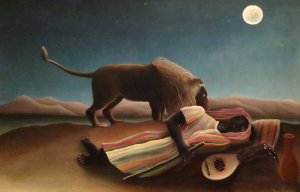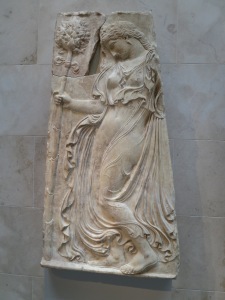Archive for November 2015
Unreason in an Age of Reason
Sigmund Freud famously called dreams “the royal road to the unconscious,” as they often reveal our inner lives with a frankness and immediacy of which we are incapable during our normal waking experience. In his view, our sexual and aggressive instincts constantly pull us in directions that we can’t face or acknowledge, as they squarely contradict the dictates of our socially-trained moral intuitions. And so, some subset of our fears and desires are pushed off the stage of our daylight consciousness, to come popping out and night as we sleep. There’s a kind of law of conservation of psychic energies – they can be redirected or displaced, but never destroyed.
We collectively process and share unconscious images through myths, which have a dream-like character and, as Carl Jung elucidated, display recurrent patterns or symbols which are found the world over, which he called archetypes of the collective unconscious. This does not refer to Platonic forms or any kind of mystical ground of all consciousness, it is simply a way of talking about the fact that many unconscious symbols seem to be part of the shared human heritage.
This idea was taken over from the pioneering anthropologist Adolph Bastian, who discovered in his comparative analysis of many traditions what he called “elementary ideas,” or Elementargedanken. So the gods send a world-ending flood to terminate a bungled mankind not just in the Gilgamesh Epic and Flood Story of Genesis, but in the Mayan Popol Vuh as well. Trickster figures of remarkably similar character are found the world over – compare the Norse troublemaker Loki with the Tlingit and Haida Raven, or the Siberian Rabbit. And so on.
Dreams and myths speak in a common language which directly render aspects of experience in images suffused with the energies of instinct, connecting the world of consciousness to the biological facts of the body, and coordinating those two planes of our being. By definition, these symbols fascinate, disturb, and thrill. This is why Independence Day sold a lot of tickets, but Star Wars created a following that persists to this day. When the voice of Obi Wan Kenobi tells Luke to put aside his targeting computer and use the Force, he is saying something that audiences instinctively recognize. We may think that our tools and our intellects are piloting the vessels of our lives, but deeper instincts and energies are the real driver. That’s why this scene provides exultation, release, and delight – the manifest content of the film is a trivial space opera, but its message is profound.
What we need to fully appreciate is that myth and dream are not light entertainments, or a fanciful diversion from the rationally-ordered scientific and economical world in which we really live. This is an age of science, and the great discoveries made possible by the scientific method endanger our groundedness in our manifold human nature by prompting many people to over-identify with our rational centers, and to view the worlds of dream, feeling, and instinct as trivial asides. It is as though we would lop off the second term in our age-old definition of man as “rational animal.”
We do so at our peril, because we are animals, and we are moved by the unconscious. Deciding that the unconscious is of no value or interest does not make it go away – on the contrary. To ignore it is to leave it dangerously unintegrated, and unchecked.
Joseph Campbell expressed the matter succinctly in his Masks of God series:
Clearly mythology is no toy for children. Nor is it a matter of archaic, merely scholarly concern, of no moment to modern men of action. For its symbols (whether in the tangible forms of images or in the abstract form of ideas) touch and release the deepest centers of motivation, moving literate and illiterate alike, moving mobs, moving civilizations. There is a real danger, therefore, in the incongruity of focus that has brought the latest findings of technological research into the foreground of modern life, joining the world a single community, while leaving the anthropological and psychological discoveries from which a commensurable moral system might have been developed in the learned publications where they first appeared. For surely it is folly to preach to children who will be riding rockets to the moon a morality and cosmology based on concepts of the Good Society and of man’s place in nature that were coined before the harnessing of the horse! And the world is now too small, and men’s stake in sanity too great, for any of those old games of Chosen Folk (whether of Jehovah, Allah, Wotan, Manu, or the Devil) by which tribesmen were sustained against their enemies in the days when the serpent still could talk.
Just as individuals have stages of greater or lesser degrees of mental integration, coherence, and health, so, too, do societies. I was first alerted to the critical importance of this fact reading Jung in my early 20s. He was not a political man, and was reticent to comment on even the most serious social issues, but he nonetheless observed first-hand that the rise of the Nazi ideology was a direct illustration of the dangers posed by the unconscious. As the archetype of the eternal swastika rolling forever like a cosmic wheel swept like wildfire across German-speaking lands, great masses of people were galvanized by archetypes of the collective unconscious. In a short essay, he argued disturbingly and persuasively that the principle silent mover of the Nazi ideology was none other than Wotan or Odin, the repressed shadow-opposite of Germany’s Christian self-identity. Wotan is a truly awful war god who sets armies on the move in the Period of Migrations and Viking Age, and he demands human sacrifice.
Jung’s follower Erich Neumann took up the social analysis of the unconscious as thematic for his work. In his monumental study The Origins and History of Consciousness, he tracks out the development of mythology as the collective working-out of the conscious parameters of individual development. For example, when the possibility first emerged in history that the individual might carve out their own autonomous destiny in contradistinction to the role assigned to them by the tribe or society, we saw the emergence and rapid spread of myths showing hero figures overthrowing a primordial god or goddess that threatened to swallow and overwhelm the individual in its matrix, such as we find in the Babylonian Enuma Elish, in which the hero Marduk slays Tiamat, a quintessential expression of the “devouring mother” archetype.
In Neumann’s view, social change and social revolution require a concordant adaptation by the collective unconscious, which is comprised by the shared set of guiding symbols that organize and direct our instinctual patterns of belief and activity. These are generally articulated through myth and mythological symbol, and the study of myth – and of art, literature, poetry, and related fields – is therefore a royal road to the collective unconscious, which can alert us to the contours of this landscape, and the pitfalls and the promises of our historical situation.
The twentieth century was the great period of discovery of the unconscious by Europe, but what we worked so hard to learn, we have now largely forgotten. Our artists are regarded as entertainers, by and large, and our arts increasingly become entertainments. And the techno-Utopian character of our age regards social problems as best analyzed and best solved by scientists, as though technical skills provide a general tool kit for understanding and dealing with any problem in any domain. This much is clear from our New York Times best sellers.
Carl Jung warned that what remains unconscious returns as fate, and I daresay that history will remind us of what we have chosen to forget. This has been a dark year in world history, and still-darker clouds gather on the horizon. Our public discourse has, in the main, virtually no sensitivity to or appreciation of the facts of the unconscious, and social turmoil is exclusively articulated and processed as a matter of competing positions. The more this limited framework strangles the life out of the real human energies driving historical conflict, the more shrill, polarizing, and ineffectual public discussion will become.
To me it seems perfectly obvious that you cannot understand the ability of putatively-rational people to ignore the overwhelming evidence for anthropogenic climate change without considering the role of repression. Nor can you adequately explain why the Catholic church actively concealed the systematic sexual abuse of children for decades. Nor can you understand why the dark specter of Islamic terrorism elicits a horror that is fantastically disproportionate to the actual threat that it represents without understanding something of the Jungian archetype of the Shadow.
Nor, for that matter, can you come to an elementary understanding of what Islam is, if you regard it exclusively as a historical set of positions and views, and utterly neglect it as an aesthetic, psychological, and spiritual force – and that understanding can only be won by going into it, and letting its forms and symbols speak to you.
As Joseph Campbell warned us, the world is too small for that kind of neglect. More than one billion Muslims are here on this Earth, sharing it with non-Muslims, and national boundaries are porous. The United States and Europe are in deadly peril of allowing the image of the Muslim as the shadowy other – an archetype that elicits our own repressed shadow-nature – to drive policies that are as inhuman as they are doomed to failure. And no amount of rational analysis and debate is going to solve that problem. We must enlarge our psychic horizons, we must have a broader understanding of culture and history, or we may not survive.
Whatever that image of the Other is for you, you must find your way to enter it, whether it’s the Qu’ran, Rumi, Attar, Saint Francis, Picasso, the Buddha or Einstein. Find your way in, and make it part of your own story.



